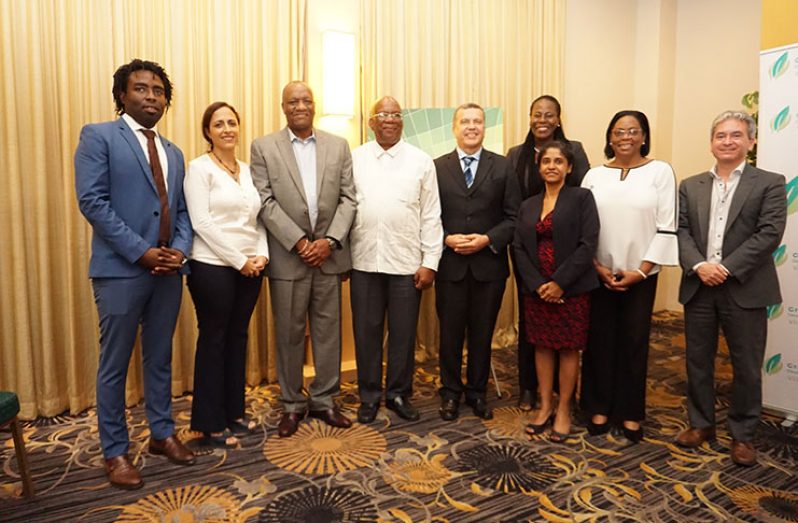– Min Jordan says strategy will not be relegated to dust bin of history
THE developmental objectives of the ‘Green State Development Strategy: Vision2040’ would be fulfilled through the use of revenues streaming from the Oil and Gas Sector, Minister of Finance Winston Jordan has said.
GSDS: Vision2040 promotes three central messages – manage natural resource wealth; support economic resilience; and build human capital and institutional capacity.
“The first key message – manage natural resource wealth, in particular, requires my Ministry of Finance to channel revenues from oil and gas into the National Budget to fund the development objectives of the Green State Development Strategy,” Minister Jordan said.
At the time he was delivering the keynote address at a cocktail reception held at the Pegasus Hotel on Tuesday to celebrate the completion of Volumes I and II of GSDS: Vision2040. The strategy was presented to President David Granger in the presence of his Cabinet earlier on Tuesday by United Nations (UN) Environment Regional Director of the Office for Latin America and the Caribbean (Panama), Leo Heileman.
GSDS: Vision2040 is intended to be a living example of Guyana’s commitment to the planet while ensuring the sustainable growth and economic well-being of its population. It will guide Guyana’s national development policies for the next 20 years.
Minister Jordan said President Granger has mandated Cabinet to prioritize the work necessary for the implementation of GSDS: Vision 2040. It was explained that the Natural Resource Fund, Guyana’s version of the Sovereign Wealth Fund, also has three broad objectives, among them use for development purposes. “It is to the third purpose, uses for development purposes, that the GSDS would be guiding the document, and the budget purpose would be the implementation instrument,” Minister Jordan said.
He, however, explained that all resources destined for the Natural Resource Fund would go directly into that fund, and not the Consolidated Fund, in keeping with the Natural Resource Fund Act.
“Whatever funds are required to be moved from the Natural Resource Fund, for the purpose of the budget to meet GSDS goals, would be withdrawn from the fund and deposited directly into the Consolidated Fund,” Minister Jordan said while adding that “the appropriation process takes place only after the National Assembly has given its approval.”
He assured UN Environment and other critical partners in the process, that the strategy, under the A Partnership for National Unity + Alliance for Change (APNU+AFC) Administration would be effectively implemented. “This Administration does not intend to have this strategy suffer the same fate as others relegated to the dust bin of history or condemned to the shelf in the dusty and molly room,” the Finance Minister said.
While alluding to Guyana’s natural wealth, Minister Jordan said it is incumbent upon leaders, at every level, to demonstrate true partnership and patriotism as the country progresses into a Green State.
“Green must not only recall issues in environmental management, it should also connote the sustainable development and management of all of our human resources…Our education system for example, must be responsive to the 21st century developmental challenges. This means that early childhood education must foster creativity; our primary level must be able to stimulate innovative thinking, our secondary school system must support original thinking and offer a balanced range of educational opportunities that would mould our young people into lifelong learners who are critical thinkers and promoters of innovation rather than followers,” the Finance Minister implored.
Director-General of the Ministry of the Presidency, Joseph Harmon, who was among officials present, described the strategy as a “visionary” and “human” document. Harmon said he is pleased to have witnessed the completion of Volumes I and II of the strategy after two and a half years of extensive consultation using a “bottom-up approach.” He, like other speakers at the forum, underscored the importance of effective implementation.
“We need to have an implementation phase that will make this a household name, in every Guyanese home. Because this strategy came from a bottom up approach, I believe already Guyanese people are aware of it. Already they know what the Green State Development Strategy is because it came from them,” he posited. Harmon also used the opportunity to applaud the key players behind the crafting of the document.
Head of the Department of Environment, Ndibi Schwiers; UN Environment Regional Coordinator, Resource Efficiency Sub-Programme, Adriana Zacarias Farah; and UN Environment Regional Director, Regional Office for Latin America and the Caribbean (Panama), Leo Heileman were among the other officials present.
Prior to the reception, Department of Environment and UN Environment Programme (UNEP) hosted its 11th and final Advisory Committee Meeting, which is a multi-stakeholder committee of the GSDS. The meeting marked the formal conclusion of the process to develop the GSDS: Vision 2040, which would be implemented from 2020.
The Advisory Committee comprises senior representatives from several Government and Private Sector entities who serve as chairs and co-chairs of each of the seven thematic expert groups of the GSDS. The meetings have been held since 2018 with the overall objective of guiding and providing institutional support for the elaboration of the Guyana Government’s commitment to the GSDS Vision: 2040, which was mandated by President Granger.
The Committee used the framework of the GSDS in 2017 as a term of reference to develop the GSDS: Vision 2040. “We were cognisant of ensuring that developing the Green State Development Strategy, that it was a document developed by Guyanese. This document was not developed easily; it required the effort, time and energy of you [the stakeholder] and provide for the development of people and the improvement of the environment and moving forward we want to ensure that our M&E [Monitoring and Evaluation] framework is aligned with Budget 2020,” Schwiers said.
Co-Chair of the GSDS Advisory Committee and Director of the Office of the Budget, Ministry of Finance, Sonya Roopnauth said although the meeting serves as an end of the first phase, there is still work to be done to implement the strategy.
“[The development of the GSDS] in its totality is the start of a lot of hard work that is going to go into making [it] a reality and this is going to be guiding the input into the National Budget process. So the content of the National Budget will now be driven by the content of the Green State Development Strategy,” she said.
Meanwhile, UNEP’s Environment Director – Latin America and the Caribbean, Leo Heileman, underscored the importance of marketing the GSDS. He urged that the financial aspect of the country be aligned with this strategy to advance Guyana’s development further into the 21st Century.
“I think that this is a beacon of light for the Caribbean community. What you have here brings the country in a clear direction and it is a remarkable achievement which will ensure the best use of its resources. For us, this is a fundamental document that gives the policy direction other countries not only in the Caribbean, will look into this as a visionary approach… I have had feedback from some countries who have heard a bit about this and there is interest about what is happening in Guyana. They see this as a sort of a pivotal moment in the Caribbean; they see this as something that they need to consider and learn from,” he said.
GSDS: Vision 2040 is aligned with the United Nations Sustainable Development Goals (UNGDG).



.jpg)









